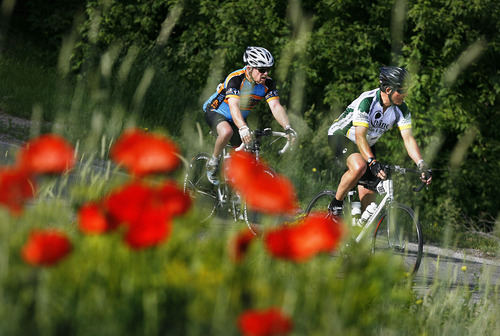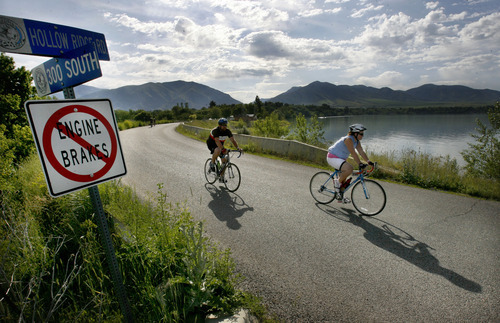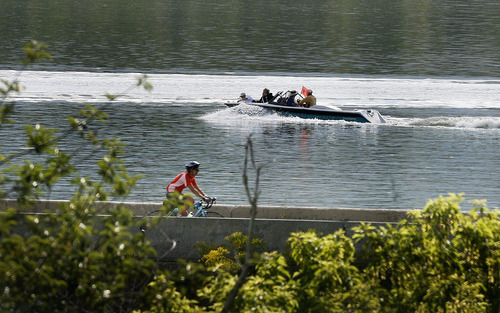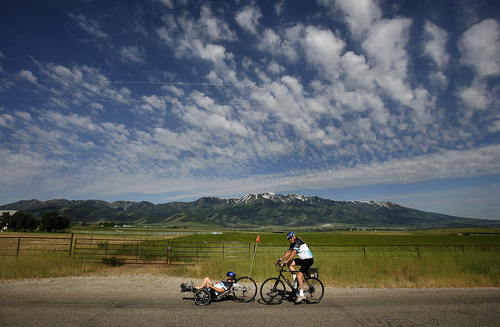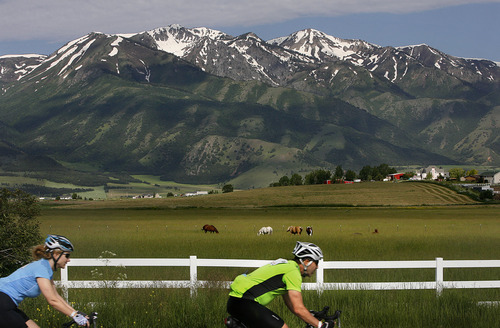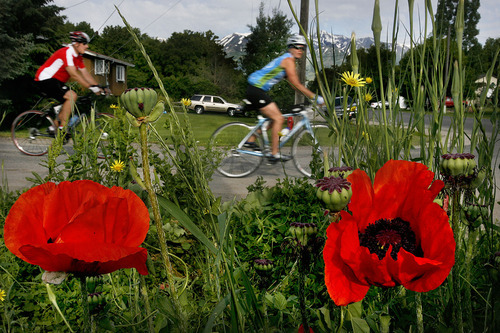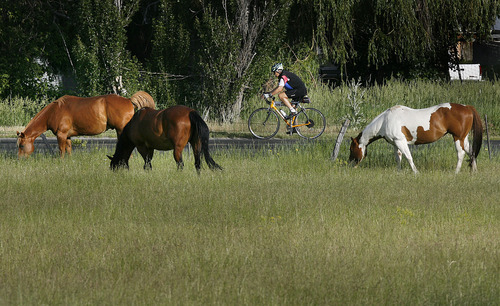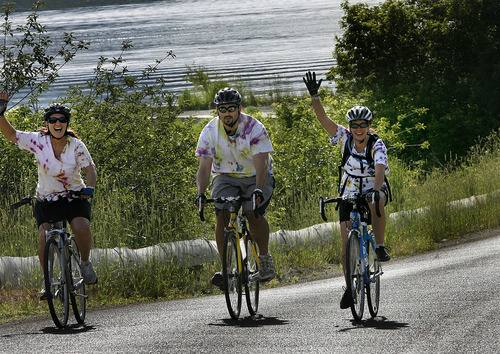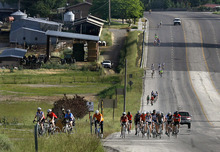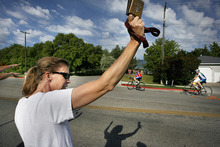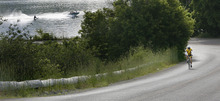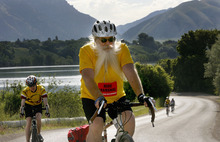This is an archived article that was published on sltrib.com in 2011, and information in the article may be outdated. It is provided only for personal research purposes and may not be reprinted.
Logan • When the going got tough for Al Leavitt on a 100-mile bike ride through Cache Valley's hilly terrain this weekend, he found motivation by thinking of his Riverton neighbor.
Diagnosed with multiple sclerosis — a chronic and sometimes disabling disease that attacks the central nervous system — Ken Allred had staggered through a 3-mile walk earlier this year as part of a fundraising campaign for MS research.
"At 90 miles, I thought, 'I can't do this,' " Leavitt said after finishing the ride Sunday. "But then I thought of my neighbor and how it took him three hours to walk 3 miles. And I thought if he can do that, I can do this."
It was Allred's perseverance in living with the disease and its symptoms that inspired Leavitt to sign up for the Bike MS: Harmons Best Dam Bike Ride event in Logan.
The two-day event drew nearly 3,000 riders and raised about $1.4 million for research. Riders — some experts and some biking for the first time in an organized race — could choose from 40-, 75- and 100-mile routes on Saturday, with the option of biking more on Sunday to complete a 175-mile course.
The 25th annual ride was a chance to honor those who live with a disease that afflicts 400,000 people in the U.S. and an estimated one in every 300 people in Utah.
A can-do spirit was present among most riders, including Ruth Flanagan, who crossed the race's finish line at Cache County Fairgrounds on Sunday after biking the full 175-mile route with an orange sign on her back proclaiming, "I ride with MS."
As music blasted over stereos and red and black balloons decorated the scene, Flanagan's support group shook cow bells to cheer her on and proudly proclaimed, "You're my hero!" when she finally stopped after the two-day trek.
Flanagan was diagnosed with MS in Australia in 2004, and relocated to Park City four years ago because of her husband's job. She started treatment at the University of Utah with neurologist John Rose, who rode with Flanagan and other patients on Team Brain at the weekend event.
MS stole Flanagan's ability to run, because the disease causes balance issues on her body's right side, but biking is a sport she is still able to enjoy, she said.
"It's always in the back of your mind," she said of wondering whether MS will prevent her from being as active as she'd like in the future. "We need to keep moving while we can."
Another participant, Bruce Jones, of New Jersey, lost his wife to MS in 1995. Tamera Walker-Jones was diagnosed six months after the couple married, but the disease went into a 15-year remission, during which she gave birth to the couple's six children. In 1981, after the birth of her youngest daughter, Lauren, Tamera began exhibiting symptoms that worsened until her death, Jones said.
Each year, Jones, his son David and Tamera's brother and sister-in-law, Blaine and Hilea Walker, of Sandy, ride to remember the woman and the courage she exhibited while living with MS.
"It's a yearly reminder that she is still a motivation in our lives," said David Jones, of Salt Lake City.
Salt Lake City law firm Richards, Brandt Miller and Nelson, like dozens of other businesses, rallied employees to bike in the event. The law firm's 13 riders also rode in honor of one of its founding partners, Bill Richards, who died in 2002 after living with the disease for years, said attorney Bob Stevens.
"Bill could walk for short distances with a cane in his hand. He would plateau and go through a period of debilitation," Stevens said. Through it all, he recalled, his friend and mentor kept a positive attitude.
Juliann Fritz, a spokesman for the national MS Society, said this year's event is significant because it marks advances in the quest for a cure. Twenty-five years ago, Bike MS started with just 100 riders, at a time when there were no treatments.
There are currently seven FDA-approved disease-modifying therapies changing the course of the disease, Fritz said. Last year, oral therapy was approved, bringing a treatment option that is less invasive than the other injection options, Fritz said.
"There is still no cure for MS, but we're making progress," she said.
Building on that progress is why Kim Gerard, of Salt Lake City, organized Team FLH (Faith, Love, Hope) in honor of her Park City friend, Laurel Spencer, who was diagnosed with MS nine years ago.
"She is the reason we started this team and the reason we work very hard for a cure. Those of us who can ride, ride," Gerard said.
Spencer saw her once-active lifestyle of skiing and backpacking change when she was forced to use a wheelchair while traveling. However, her condition has improved enough that she hopes to bike 10 miles next year at Bike MS. She said she is humbled that a team bikes in her name, and she's honored and happy the group raised $51,000 for MS research. Gerard said the event was a great way to combine awareness with a good time.
"We recognize the most important thing is to find a cure. The second most important thing is to have fun," she said.
Twitter: @mrogers_trib —
About multiple sclerosis
MS is an often-disabling disease of the central nervous system. Symptoms range from numbness to tingling to blindness and paralysis. The advancement of specific symptoms cannot be predicted, and there is no cure.
Most people with MS are diagnosed between the ages of 20 and 50, with more than twice as many women as men who are afflicted.
Utah has one of the highest incidence rates of MS in the U.S., with one in 300 people affected. MS is attributed to a combination of environmental and genetic factors, occurring more frequently among people of northern European ancestry and in higher latitudes north of the equator.
Donate or learn more at nationalmssociety.org or curemsutah.com
Source • National MS Society



